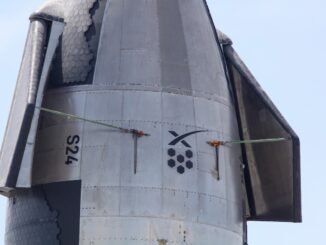
An international oceanography satellite arrived at its California launch base from a factory in France on Thursday for fueling, testing and other final preps before its scheduled Aug. 8 blastoff on a Falcon 9 rocket.
Packed inside a specialized shipping container, the Jason 3 spacecraft journeyed from a Thales Alenia Space assembly plant in Cannes, France, to Vandenberg Air Force Base in California, the prime U.S. launch site for Earth observing satellites.
The craft touched down on Vandenberg’s runway aboard a Boeing 747F freighter at 1734 GMT (1:34 p.m. EDT; 10:34 a.m. PDT), according to an update posted on NASA’s website.
Ground crews planned to transport the satellite to SpaceX’s payload processing facility at Space Launch Complex 4-East after offloading the spacecraft from the cargo plane.
Technicians from Thales and SpaceX will prepare the satellite for launch. Inspections, fueling and mating with the Falcon 9 booster are scheduled over the next six weeks.
The shipment of Jason 3 from France to California was delayed to complete an investigation into salt contamination discovered in one of the four rocket thrusters on the spacecraft.
The technical issue has been resolved, according to NOAA, which leads the U.S. contribution to the joint mission. The problem triggered a launch delay from July 22.
Liftoff of the Falcon 9 rocket with Jason 3 is set for 0347 GMT on Aug. 9 (11:47 p.m. EDT; 8:47 p.m. PDT on Aug. 8), a NASA spokesperson said.

Eumetsat, the operator of Europe’s weather satellites, is NOAA’s partner on the Jason 3 mission. The French space agency — CNES — contracted with Thales Alenia Space to build the Jason 3 satellite platform, and NASA managed the purchase of instruments and launch services for the $350 million mission.
The Falcon 9 rocket will deploy Jason 3 into orbit 830 miles above Earth, where the 1,124-pound spacecraft will measure the ocean roughness, sea level and wave heights around the world.
The data will contribute to climate change predictions, hurricane forecasting, tide prediction, and the development of long-range El Nino and La Nina outlooks. Marine biologists, emergency responders and maritime companies could also use Jason 3 measurements, scientists said.
The mission is the fourth in a line of sea surface topography satellites launched since 1992. It will replace the Jason 2 satellite launched in 2008.
Jason 3 marks SpaceX’s first flight under the management of NASA’s Launch Services Program, the agency’s rocket procurement division which conducts engineering oversight for launches of Earth science observatories, astronomy missions and interplanetary probes.
The launch experts provide an extra layer of oversight, helping allow NASA to self-insure launches of its research spacecraft. Commercial satellite operators normally purchase insurance coverage ahead of their launches.
The launch of Jason 3 will be SpaceX’s second flight from Vandenberg. The company’s first launch from the West Coast launch facility occurred in September 2013.
Email the author.
Follow Stephen Clark on Twitter: @StephenClark1.



